Abstract
OBJECTIVES--To evaluate the effects of chronic exposure to lead on the peripheral nervous system in lead workers. METHODS--Nerve conduction velocity and electromyographic studies were performed on 31 lead workers of a battery recycling factory and 31 sex and age matched controls. 25 cases with mild distal extensor weakness of the upper limbs were classified as the lead neuropathy subgroup and the rest of the lead workers as the lead exposure subgroup. Blood lead concentrations and haematological and biochemical data were recorded. An index of cumulative exposure to lead was calculated by the summation of multiplying the average blood concentration of lead with the duration of exposure at various jobs. RESULTS--Compared with the control group, the distal motor latency of the median nerve was significantly prolonged in the lead neuropathy subgroup, but not in the exposure subgroup. Only six of 31 workers had nerve conduction abnormalities, whereas electromyographic evidence of denervation was found in 93.5% of the lead neuropathy subgroup and 83.5% in the lead exposure subgroup. The electromyographic abnormalities found were neurogenic polyphasic waves in all 29 workers with abnormal electromyographic findings (grade in seven cases and grade ++ in the rest). Spontaneous activity was only recorded in seven workers, with grade + in four and grade ++ in three. There was a positive linear correlation between the index of cumulative exposure to lead and the distal motor latencies of the tibial nerve as well as a negative correlation with conduction velocities of the sural nerve after multivariate analysis and control of potential confounding by age and sex. No correlation could be found between the electrophysiological values and a simple duration of exposure or concentration of blood lead. A non-parametric analysis showed that there was a trend of higher index of cumulative exposure to lead with more severe electromyographic changes. Electromyographic abnormality also occurred in workers with blood lead concentrations between 17.4 and 58 micrograms/dl. CONCLUSION--Electromyographic study in the distal extensors of the upper limbs may be used as a tool for biological monitoring of effect in lead workers.
Full text
PDF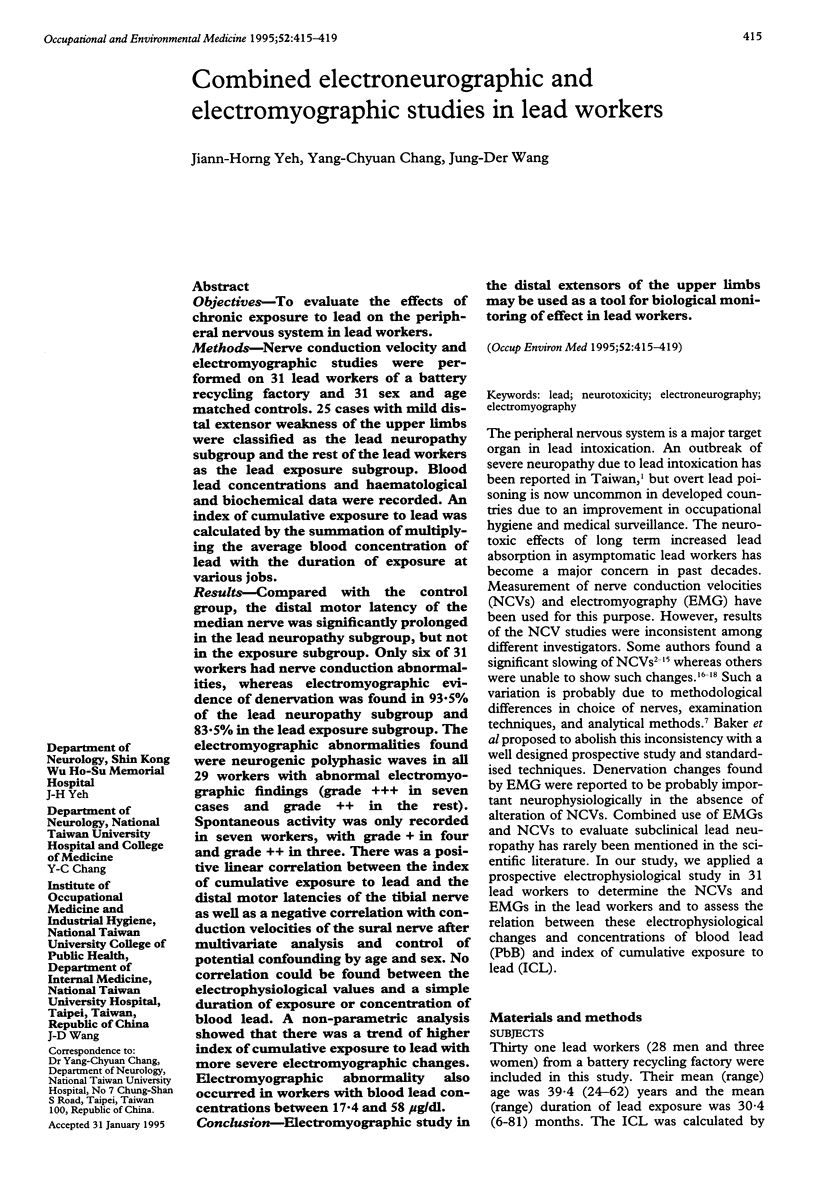
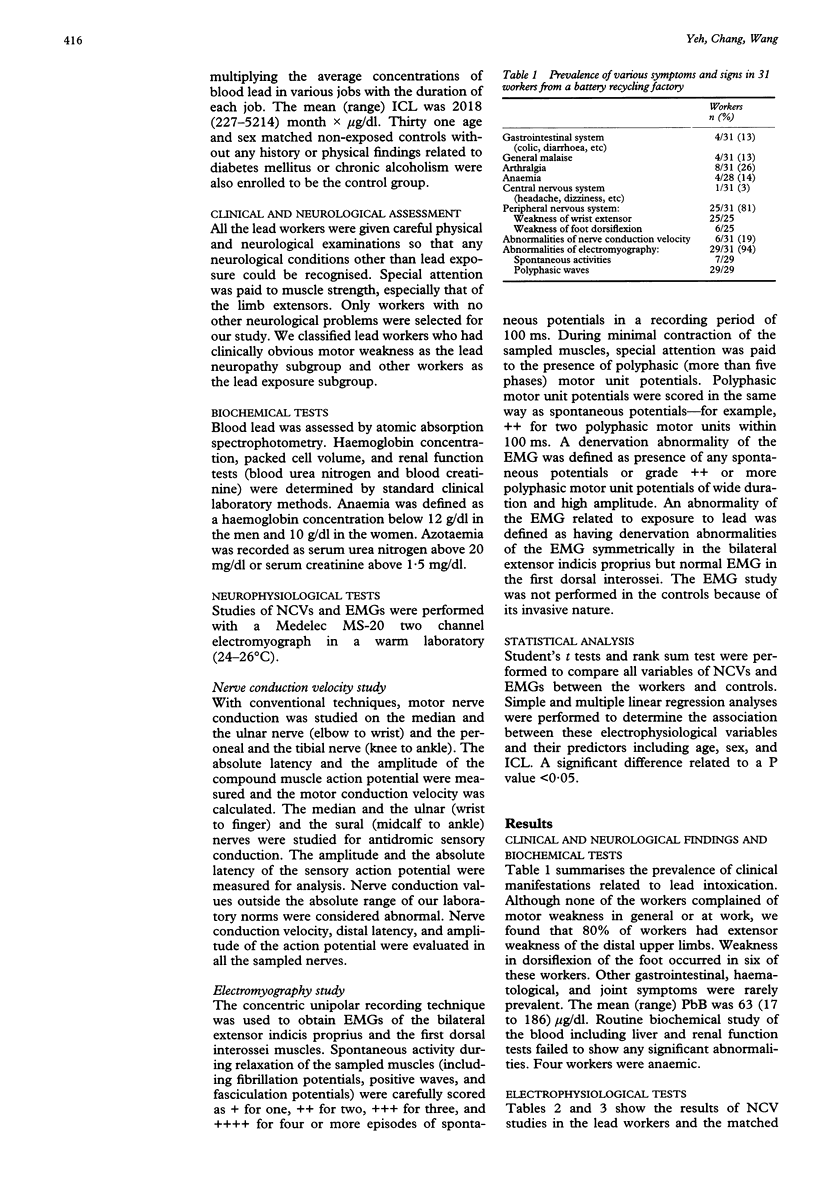
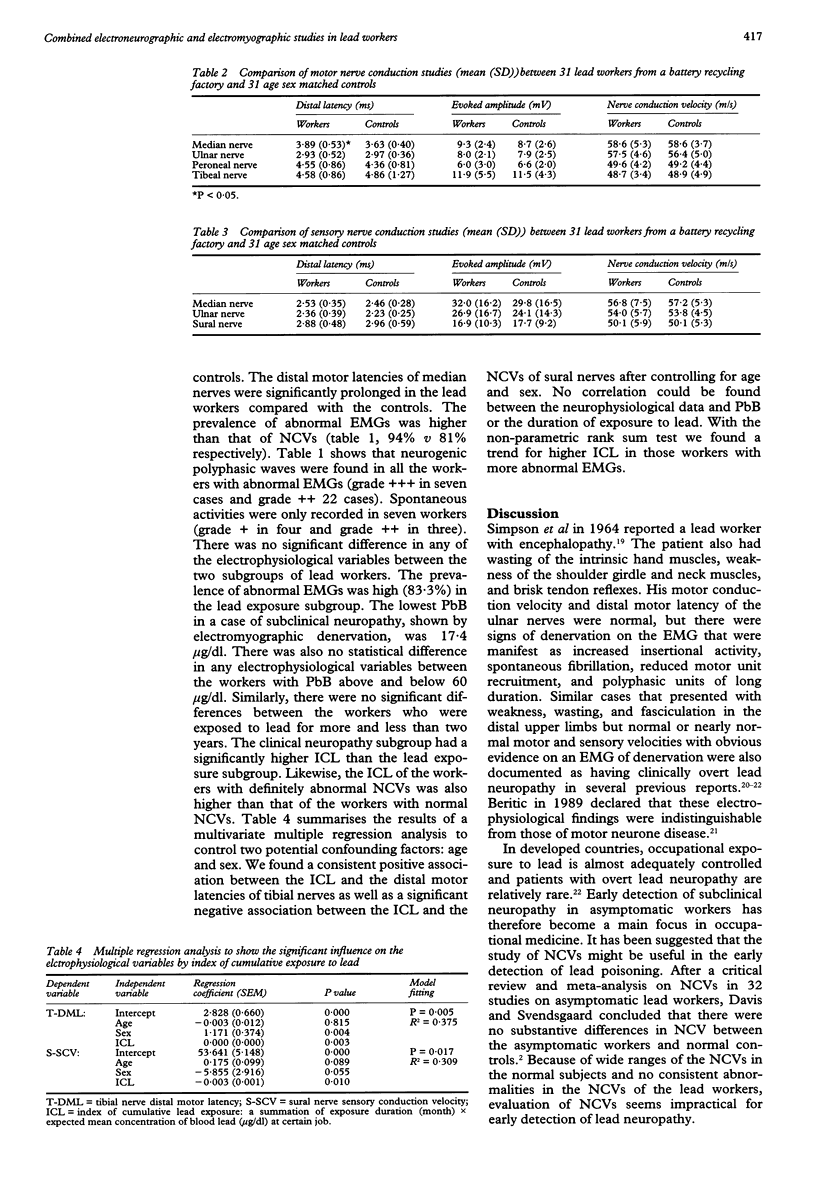
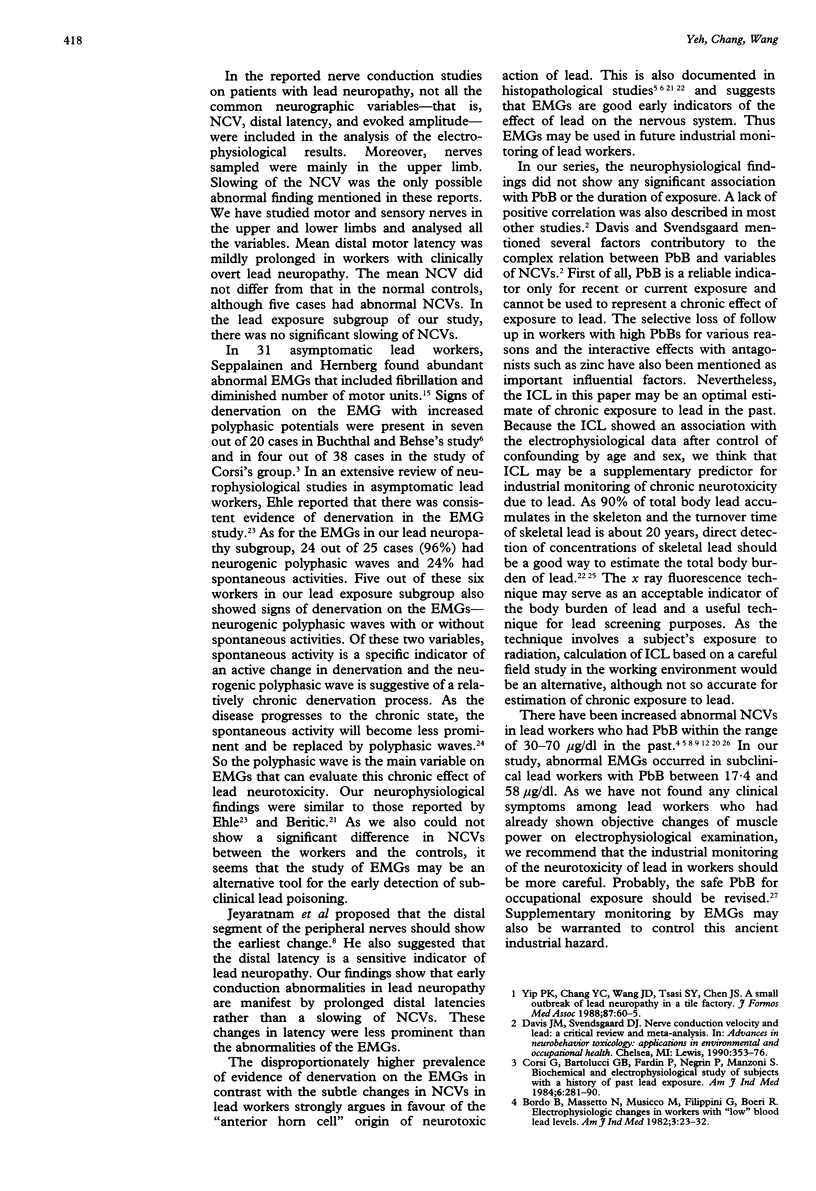
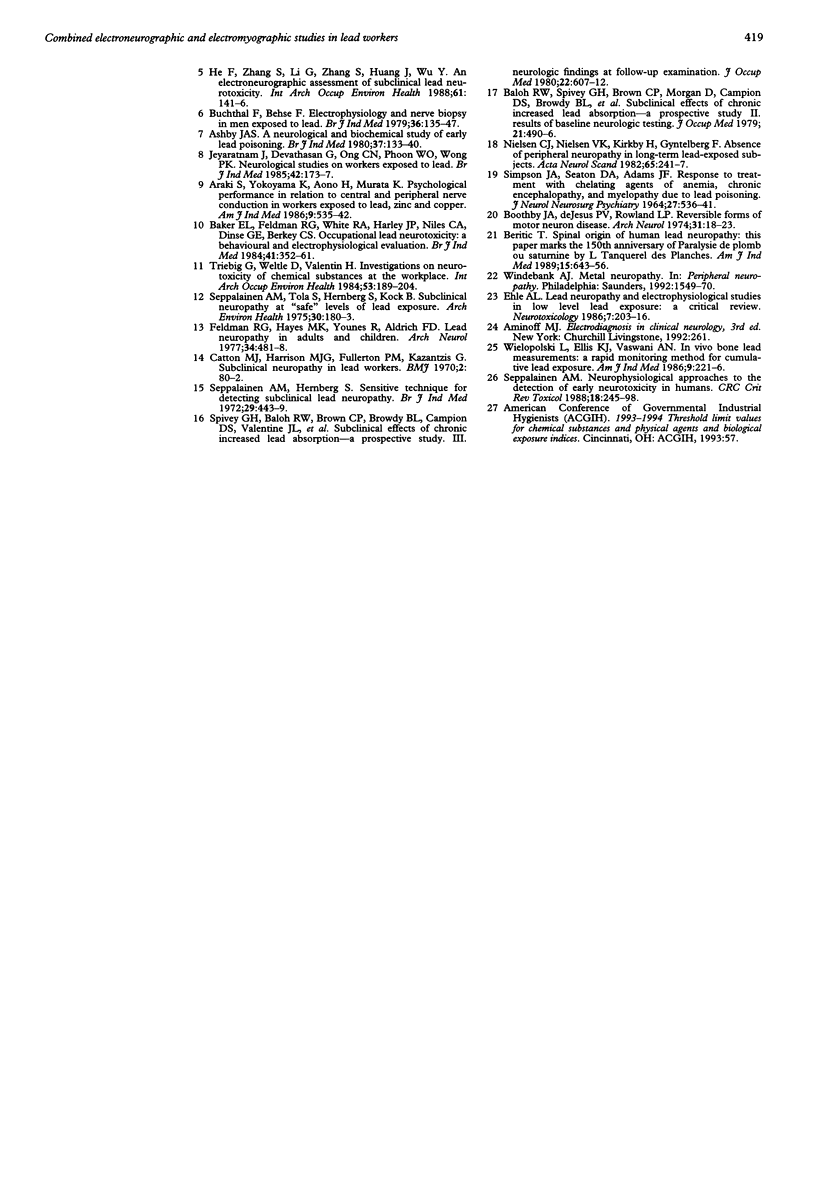
Selected References
These references are in PubMed. This may not be the complete list of references from this article.
- Araki S., Yokoyama K., Aono H., Murata K. Psychological performance in relation to central and peripheral nerve conduction in workers exposed to lead, zinc, and copper. Am J Ind Med. 1986;9(6):535–542. doi: 10.1002/ajim.4700090605. [DOI] [PubMed] [Google Scholar]
- Ashby J. A. A neurological and biochemical study of early lead poisoning. Br J Ind Med. 1980 May;37(2):133–140. doi: 10.1136/oem.37.2.133. [DOI] [PMC free article] [PubMed] [Google Scholar]
- Baker E. L., Feldman R. G., White R. A., Harley J. P., Niles C. A., Dinse G. E., Berkey C. S. Occupational lead neurotoxicity: a behavioural and electrophysiological evaluation. Study design and year one results. Br J Ind Med. 1984 Aug;41(3):352–361. doi: 10.1136/oem.41.3.352. [DOI] [PMC free article] [PubMed] [Google Scholar]
- Baloh R. W., Spivey G. H., Brown C. P., Morgan D., Campion D. S., Browdy B. L., Valentine J. L., Gonick H. C., Massey F. J., Jr, Culver B. D. Subclinical effects of chronic increased lead absorption--a prospective study. II. Results of baseline neurologic testing. J Occup Med. 1979 Jul;21(7):490–496. [PubMed] [Google Scholar]
- Beritić T. Spinal origin of human lead neuropathy: this paper marks the 150th anniversary of Paralysie de Plomb ou Saturnine by L. Tanquerel des Planches. Am J Ind Med. 1989;15(6):643–656. doi: 10.1002/ajim.4700150604. [DOI] [PubMed] [Google Scholar]
- Boothby J. A., DeJesus P. V., Rowland L. P. Reversible forms of motor neuron disease. Lead "neuritis". Arch Neurol. 1974 Jul;31(1):18–23. doi: 10.1001/archneur.1974.00490370044005. [DOI] [PubMed] [Google Scholar]
- Bordo B., Massetto N., Musicco M., Filippini G., Boeri R. Electrophysiologic changes in workers with "low" blood lead levels. Am J Ind Med. 1982;3(1):23–32. doi: 10.1002/ajim.4700030106. [DOI] [PubMed] [Google Scholar]
- Buchthal F., Behse F. Electrophysiology and nerve biopsy in men exposed to lead. Br J Ind Med. 1979 May;36(2):135–147. doi: 10.1136/oem.36.2.135. [DOI] [PMC free article] [PubMed] [Google Scholar]
- Catton M. J., Harrison M. J., Fullerton P. M., Kazantzis G. Subclinical neuropathy in lead workers. Br Med J. 1970 Apr 11;2(5701):80–82. doi: 10.1136/bmj.2.5701.80. [DOI] [PMC free article] [PubMed] [Google Scholar]
- Corsi G., Bartolucci G. B., Fardin P., Negrin P., Manzoni S. Biochemical and electrophysiological study of subjects with a history of past lead exposure. Am J Ind Med. 1984;6(4):281–290. doi: 10.1002/ajim.4700060406. [DOI] [PubMed] [Google Scholar]
- Ehle A. L. Lead neuropathy and electrophysiological studies in low level lead exposure: a critical review. Neurotoxicology. 1986 Fall;7(3):203–216. [PubMed] [Google Scholar]
- Feldman R. G., Hayes M. K., Younes R., Aldrich F. D. Lead neuropathy in adults and children. Arch Neurol. 1977 Aug;34(8):481–488. doi: 10.1001/archneur.1977.00500200041008. [DOI] [PubMed] [Google Scholar]
- He F. S., Zhang S. L., Li G., Zhang S. C., Huang J. X., Wu Y. Q. An electroneurographic assessment of subclinical lead neurotoxicity. Int Arch Occup Environ Health. 1988;61(1-2):141–146. doi: 10.1007/BF00381618. [DOI] [PubMed] [Google Scholar]
- Jeyaratnam J., Devathasan G., Ong C. N., Phoon W. O., Wong P. K. Neurophysiological studies on workers exposed to lead. Br J Ind Med. 1985 Mar;42(3):173–177. doi: 10.1136/oem.42.3.173. [DOI] [PMC free article] [PubMed] [Google Scholar]
- Nielsen C. J., Nielsen V. K., Kirkby H., Gyntelberg F. Absence of peripheral neuropathy in long-term lead-exposed subjects. Acta Neurol Scand. 1982 Apr;65(4):241–247. doi: 10.1111/j.1600-0404.1982.tb03083.x. [DOI] [PubMed] [Google Scholar]
- SIMPSON J. A., SEATON D. A., ADAMS J. F. RESPONSE TO TREATMENT WITH CHELATING AGENTS OF ANAEMIA, CHRONIC ENCEPHALOPATHY, AND MYELOPATHY DUE TO LEAD POISONING. J Neurol Neurosurg Psychiatry. 1964 Dec;27:536–541. doi: 10.1136/jnnp.27.6.536. [DOI] [PMC free article] [PubMed] [Google Scholar]
- Seppäläinen A. M., Hernberg S. Sensitive technique for detecting subclinical lead neuropathy. Br J Ind Med. 1972 Oct;29(4):443–449. doi: 10.1136/oem.29.4.443. [DOI] [PMC free article] [PubMed] [Google Scholar]
- Seppäläinen A. M. Neurophysiological approaches to the detection of early neurotoxicity in humans. Crit Rev Toxicol. 1988;18(4):245–298. doi: 10.3109/10408448809037468. [DOI] [PubMed] [Google Scholar]
- Seppäläinen A. M., Tola S., Hernberg S., Kock B. Subclinical neuropathy at "safe" levels of lead exposure. Arch Environ Health. 1975 Apr;30(4):180–183. doi: 10.1080/00039896.1975.10666672. [DOI] [PubMed] [Google Scholar]
- Spivey G. H., Baloh R. W., Brown C. P., Browdy B. L., Campion D. S., Valentine J. L., Morgan D. E., Culver B. D. Subclinical effects of chronic increased lead absorption--a prospective study. III. Neurologic findings at follow-up examination. J Occup Med. 1980 Sep;22(9):607–612. [PubMed] [Google Scholar]
- Triebig G., Weltle D., Valentin H. Investigations on neurotoxicity of chemical substances at the workplace. V. Determination of the motor and sensory nerve conduction velocity in persons occupationally exposed to lead. Int Arch Occup Environ Health. 1984;53(3):189–203. doi: 10.1007/BF00398813. [DOI] [PubMed] [Google Scholar]
- Wielopolski L., Ellis K. J., Vaswani A. N., Cohn S. H., Greenberg A., Puschett J. B., Parkinson D. K., Fetterolf D. E., Landrigan P. J. In vivo bone lead measurements: a rapid monitoring method for cumulative lead exposure. Am J Ind Med. 1986;9(3):221–226. doi: 10.1002/ajim.4700090304. [DOI] [PubMed] [Google Scholar]


